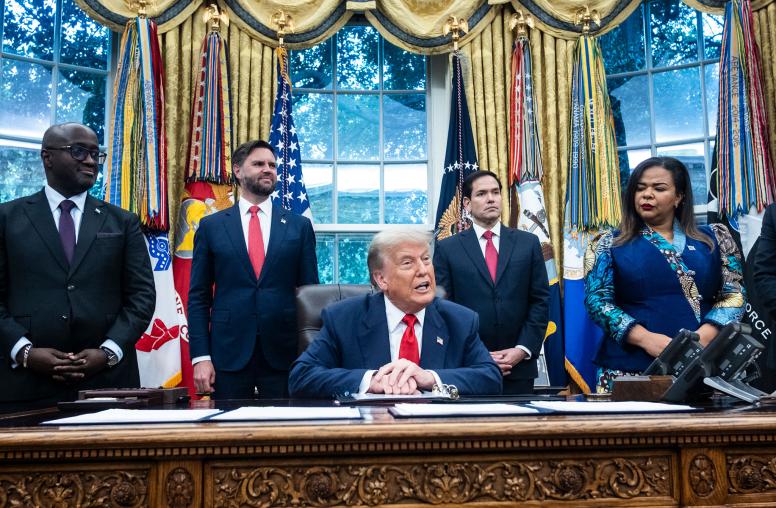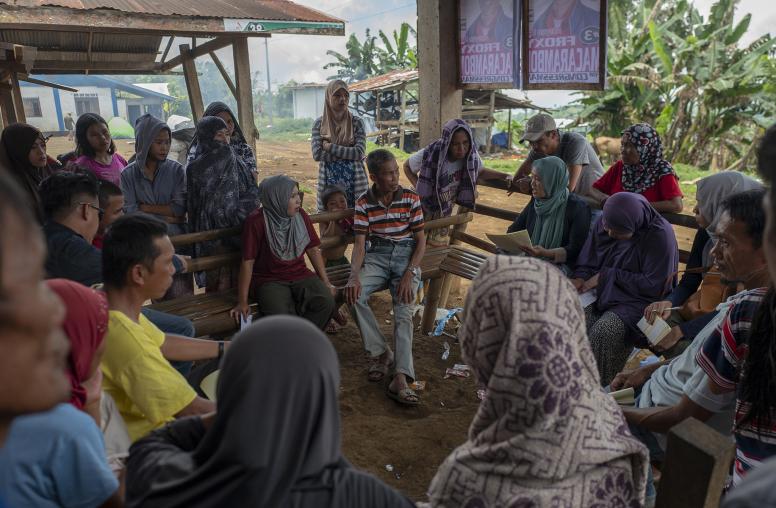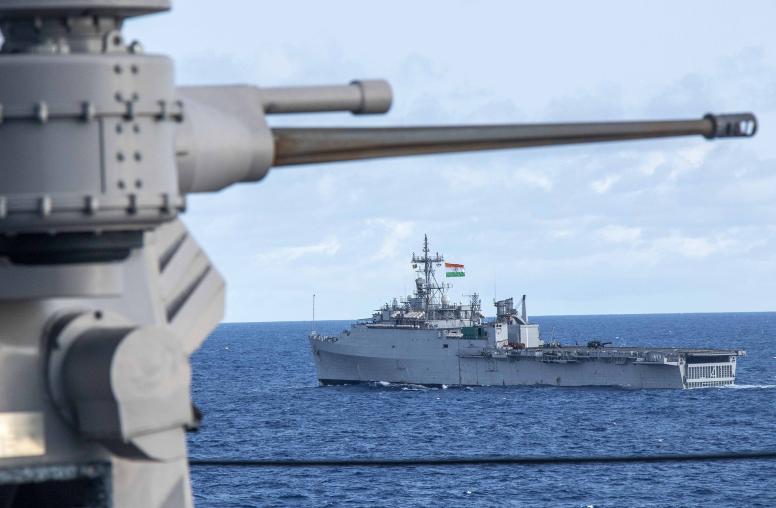2003–2004 National Winner
Vivek Viswanathan
Herricks High School
New Hyde Park, New York
Coordinator: Ms. Melissa Jacobs
While the resolution of armed conflict may bring initial order within a war-torn nation, it does not guarantee long-term peace and stability. Establishing an orderly society from the ruins of war—enacting a workable political, economic, and social structure in a place where violence and instability have been the rule—is an undertaking that is necessarily complex. Moreover, the discontinuation of armed conflict does not imply resolution of the underlying concerns that caused the conflict. Humanitarian crises can compound problems. An inability to deal with these factors intelligently and effectively can cripple the rebuilding process and lead to renewed strife.
History has shown that the most effective rebuilding efforts integrate three important strategies. First, they are tailored to the postwar situation with which they are dealing. An assessment of which factors pose the gravest challenges to rebuilding in each postconflict situation is absolutely necessary. Factors that destabilize rebuilding must not be addressed haphazardly but rather at their roots. Second, successful rebuilding involves a vast commitment of resources and assistance on the part of the international community. Piecemeal efforts will not suffice. Finally, rebuilding efforts must involve a nation's own people in a way that allows them to ultimately control their destiny and that eventually provides a clear exit strategy for international actors.
Case studies of the Marshall Plan in Western Europe and the United Nations and United States' rebuilding efforts in Somalia in the early 1990s demonstrate the necessity of correctly identifying the most fundamental and pressing challenges of rebuilding, dealing with them in a powerful and forceful way, and involving a nation's people in rebuilding efforts in order to build a strong, self-sustaining society.
The Marshall Plan is a study in successful rebuilding. When World War II ended in 1945, the European continent was in tatters. America initially believed that limited aid and relaxed trade barriers would be enough to spur Europe to economic recovery.1 But by 1947, the economic situation was dire. The United Nations reported that postwar labor productivity in Europe was 40-50 percent of prewar levels, and low wages and food shortages compounded the problems.2 As the economy tanked, support for the Communist party in various countries began to grow.3 The United States began to fear Soviet domination of Western Europe.
By 1947, Secretary of State George Marshall understood the plight of the European continent and the danger it faced. "The patient is sinking while the doctors deliberate," he told the American people.4 In a now-famous speech that year at Harvard University, Marshall laid out the European Recovery Program—the Marshall Plan—and brilliantly addressed the three important strategies of rebuilding. First, he correctly assessed the situation in Europe. Marshall realized that the root problem that afflicted rebuilding efforts was economic and not political in nature. He emphasized that the effective way to stifle Communism was to address Europe's economic troubles. "Our policy is directed not against any country or doctrine but against hunger, poverty, desperation, and chaos," Marshall said. "Its purpose should be the revival of a working economy . . . to permit the emergence of political and social conditions in which free institutions can exist."5
Second, Marshall understood that for rebuilding to succeed, a massive investment of resources into Europe on the part of the United States was necessary. "Assistance . . . must not be on a piecemeal basis . . . [it] should provide a cure rather than a mere palliative," he said.6
Finally, Marshall understood that the chances of a rational and cohesive rebuilding effort would be greatly increased by allowing Europeans to retain much control over the rebuilding program. The United States, he said, should limit itself to "friendly aid" and advice.7 The Marshall Plan's four-year timetable also provided a framework for success.
Eventually, between 1948 and 1952, the United States appropriated $13.3 billion dollars—a staggering sum in that day—for the Marshall Plan.8 The money was spent toward greatly increasing European productivity and modernizing factory and transport systems. And the Europeans had a hand in formulating a workable rebuilding policy.
The plan was incredibly successful. Western Europe's gross national product climbed 32 percent during the Marshall Plan, and by 1952 agricultural production and industrial output exceeded prewar levels by 11 and 40 percent, respectively.9 Through the revived economy, Western Europe had been re-integrated into the free world; even as the U.S.S.R. dominated Eastern Europe, Western Europe would stand for four decades as a bulwark against Soviet expansion. Calling him a man who "offered hope to those who desperately needed it," TIME named him its 1947 Man of the Year.10 And in 1953, Marshall was awarded the Nobel Peace Prize.
In contrast, the United Nations and United States' postconflict reconstruction experience in Somalia in the early 1990s demonstrates the consequences of an incompetent and halfhearted approach to nation-building. With the collapse of Mohamed Siad Barre's regime in 1991, Somalia plunged into civil war as various Somali clans engaged in a power struggle. The chaos triggered a great humanitarian crisis. Finally, after thousands were killed in intense fighting in Mogadishu, a UN-brokered cease-fire between rival clan leaders Mohamed Farah Aidid and Ali Mahdi Mohamed was achieved in March of 1992.11
However, the United Nations and United States' response afterward showed a disregard for the three important strategies of rebuilding. Firstly, the United Nations and the United States did not accurately assess the Somali situation. The immense humanitarian crisis blinded the international actors to the fact that the root problem that was afflicting reconciliation was political in nature. The initial United Nations and United States response in Operation Restore Hope sought to be purely humanitarian in nature,12when in fact the humanitarian and political situations were intertwined. The U.S. deputy chief of mission to Somalia later wrote, "The country's entire political and economic systems essentially revolved around plundered food" that was stolen from the relief effort.13 Eventually, confronted with the deteriorating political situation, the UN Security Council authorized Resolution 794 in December of 1992, which allowed U.S. and international troops to use "all necessary means" to establish "a secure environment for humanitarian relief operations in Somalia."14 Even at this point, guaranteeing political stability was seen as only a means for providing humanitarian relief, rather than an end in itself. This is a fine strategy for saving people's lives in the short-term—in fact, the intervention in Somalia saved tens of thousands of lives15—but it is a poor strategy for rebuilding the fabric of a nation.
Secondly, the international community was not eager to put forth the significant monetary and troop commitment that successful nation-building entails. However, reductions in the troop force—from 25,000 to 4,200 by June of 199316—ultimately proved counterproductive. As James Dobbins, who oversaw various postwar reconstruction efforts (including Somalia) while serving Presidents George H.W. Bush and Clinton, put it, "Only when the number of stabilization troops has been low in comparison to the population have U.S. forces suffered or inflicted significant casualties."17 The international effort in Somalia was strikingly deficient.
Finally, the Somali mission failed to include many of the Somali people in rebuilding efforts. The cease-fire efforts attempted to treat the conflict as one between two major warlords, when there were actually many other disaffected people who were not invited to peace talks.18 In fact, warlord Ali Mahdi Mohamed, given stature by his inclusion in the talks, attacked smaller clans the day after the UN invitation to talks.19 One UN adviser wrote that the international community's inability to recognize the importance of representation in Somali politics was "central to nearly every failed peace conference."20 In the end, the concept of an effective exit strategy for international actors, which is designed to focus efforts on goals and results, instead degenerated in Somalia into a rationale for getting out.
After a clash between warlord Mohamed Farah Aidid and a UN force on June 5, 1993, and the battle between Aidid and U.S. forces on October 3, 1993 that left eighteen soldiers dead, Clinton ordered a withdrawal of American troops that was completed by March of 1994.21 The final UN troops left in February of 1995 as rival clans continued to fight. As his troops prepared to leave Somalia, Pakistani brigadier general Saulat Abbas lamented, "We've been able to save a lot of people from hunger, disease. But we've not been able to contribute anything politically."22 The nation-building effort had failed.
The lessons of the Marshall Plan and international efforts in Somalia are clear. For those nations overrun by war, the cessation of violence is only a beginning. A careful and well-reasoned rebuilding and reconciliation effort that is uniquely relevant to the intricacies of each situation is necessary for the re-emergence of a strong society that can endure. In addition, international actors such as the United Nations and United States must truly be committed to investing all the resources necessary to build an orderly environment. This often means going against the prevailing political winds. Finally, the rebuilding of a nation must involve that nation's own people and provide for their society to eventually prosper on its own. With the proper approach and commitment in place, postconflict rebuilding efforts can lead to societies that are peaceful, stable, and secure.
Endnotes
1. David W. Ellwood, Rebuilding Europe: Western Europe, America, and Postwar Reconstruction (London: Longman, 1992), p. 82.
2. Robert A. Pollard, Economic Security and the Origins of the Cold War (New York: Columbia University Press, 1985), p. 64.
3. Michael Wala, The Council on Foreign Relations and American Foreign Policy in the Early Cold War (Providence, RI: Berghahn Books, 1994), p. 103.
4. Forrest C. Pogue, George C. Marshall: Statesman 1945-1959 (New York: Viking Penguin, 1987), p. 200.
5. "Transcript of Marshall Plan (1948)," Our Documents, NARA; National History Day; USA Freedom Corps, http://www.ourdocuments.gov/doc.php?flash=true&doc=82&page=transcript. January 14, 2004.
6. "Transcript."
7. "Transcript."
8. "The Marshall Plan," George C. Marshall, George C. Marshall Foundation, http://www.marshallfoundation.org/about_gcm/marshall_plan.htm#expenditures, January 12, 2004.
9. Michael J. Hogan, The Marshall Plan: America, Britain, and the Reconstruction of Western Europe, 1947-1952 (New York: Cambridge University Press, 1987), p. 431.
10. "Man of the Year: George C. Marshall," Time January 5, 1948.
11. Robert M. Press, The New Africa: Dispatches From A Changing Continent (Gainesville, FL: University Press of Floriday, 1999), p. 173.
12. "History Channel—Speeches—George Bush, Forty-First President, Addresses U.S. Troops in Somalia," http://www.historychannel.com/speeches/archive/speech_34.html. January 12, 2004. President Bush categorically stated in his speech, "It's a humanitarian mission . . . not an open-ended commitment."
13. Walter Clarke and Jeffrey Herbst, "Somalia and the Future of Humanitarian Intervention," Foreign Affairs, vol. 75. no. 2 (1996), p. 74.
14. "United Nations Operations in Somalia II (UNOSOM II) - Background," United Nations Completed Peacekeeping Operations, United Nations, http://www.un.org/Depts/dpko/dpko/co_mission/unosom2backgr2.html#four, January 11, 2004.
15. "United."
16. "History."
17. Fred Kaplan, "He Saw It Coming—The Former Bushie Who Knew Iraq Would Go to Pot," Slate 5. Aug. 2003, http://slate.msn.com/id/2086636/, January 14, 2004.
18. Press 197.
19. Jeffrey Clark, "Debacle in Somalia," Foreign Affairs vol. 72 no.11 (1993), p. 115.
20. Ken Menkhaus, "Local and National Reconciliation in Somalia," In Learning from Somalia: The Lessons of Armed Humanitarian Intervention, Walter Clarke and Jeffrey Herbst, eds., (Boulder, CO: Westview Press, 1997), p. 57.
21. Press, pp. 203, 208.
22. Press, p. 216."
Bibliography
Works Cited
Clark, Jeffrey. "Debacle in Somalia." Foreign Affairs vol. 72 no.11 (1993).
Clarke, Walter, and Jeffrey Herbst. "Somalia and the Future of Humanitarian Intervention." Foreign Affairs vol.75 no.2 (1996).
Ellwood, David W. Rebuilding Europe: Western Europe, America, and Postwar Reconstruction. London: Longman, 1992.
Hogan, Michael J. The Marshall Plan: America, Britain, and the Reconstruction of Western Europe, 1947-1952. New York: Cambridge University Press, 1987.
"Man of the Year: George C. Marshall." Time January 5, 1948.
Menkhaus, Ken. "Local and National Reconciliation in Somalia." In Learning from Somalia: The Lessons of Armed Humanitarian Intervention, Walter Clarke and Jeffrey Herbst, eds. Boulder, CO: Westview Press, 1997.
Pogue, Forrest C. George C. Marshall: Statesman 1945-1959. New York: Viking Penguin, 1987.
Pollard, Robert A. Economic Security and the Origins of the Cold War, 1945-1950. New York: Columbia University Press, 1985.
Press, Robert M. The New Africa: Dispatches From A Changing Continent. Gainesville, FL: University Press of Florida, 1999.
Wala, Michael. The Council on Foreign Relations and American Foreign Policy in the Early Cold War. Providence, RI: Berghahn Books, 1994.
Internet Sources
"History Channel – Speeches – George Bush, Forty-First President, Addresses U.S. Troops in Somalia." http://www.historychannel.com/speeches/archive/speech_34.html. January 12, 2004.
Kaplan, Fred. "He Saw It Coming – The Former Bushie Who Knew Iraq Would Go to Pot." Slate 5 Aug. 2003. http://slate.msn.com/id/2086636/, January 12, 2004.
"The Marshall Plan." George C. Marshall. George C. Marshall Foundation. http://www.marshallfoundation.org/about_gcm/marshall_plan.htm#expenditures, January 12, 2004.
"Transcript of Marshall Plan (1948)." Our Documents. NARA; National History Day; USA Freedom Corps. http://www.ourdocuments.gov/doc.php?flash=true&doc=82&page=transcript. January 14, 2004.
"United Nations Operations in Somalia II (UNOSOM II) – Background." United Nations Completed Peacekeeping Operations. United Nations. http://www.un.org/Depts/dpko/dpko/co_mission/unosom2backgr2.html#four. January 11, 2004.




